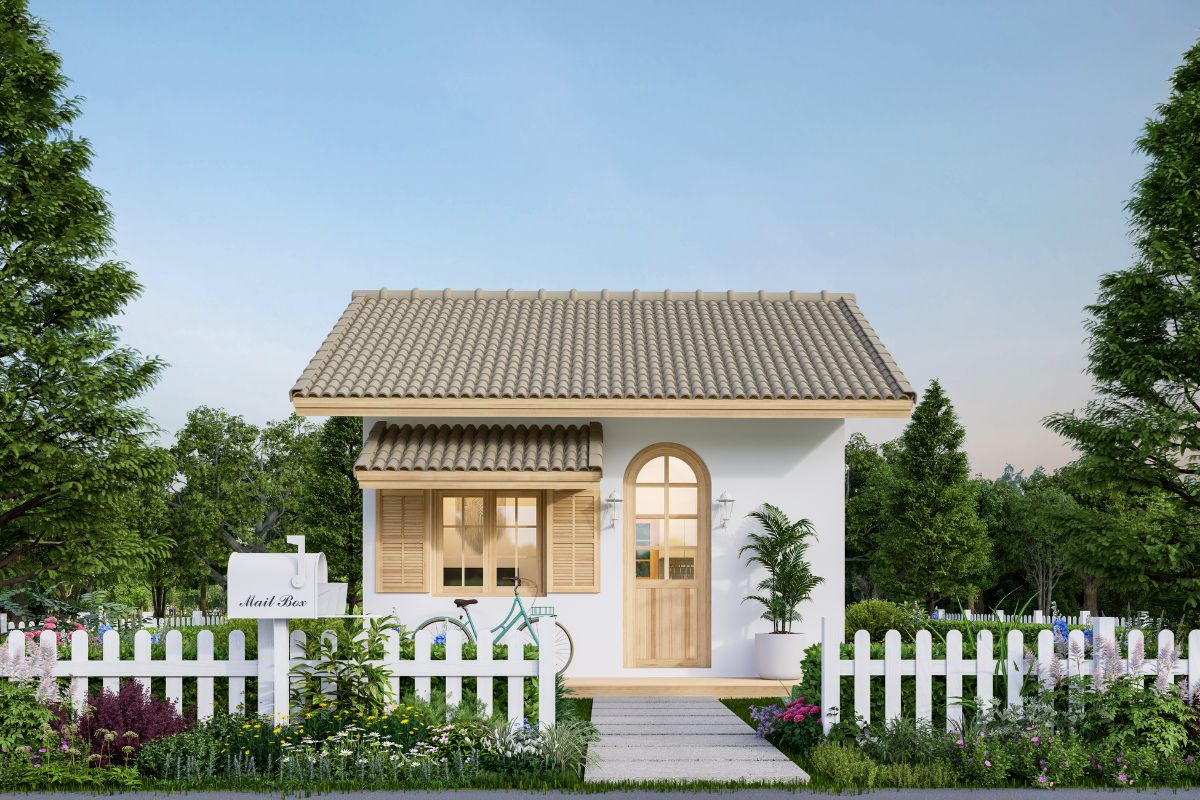Design Principles for Tiny House Landscaping
The design principles of scale and proportion are paramount when planning what to do with the space around a tiny house. Scale means the size of objects in the space against each other and their size against the space as a whole. On the other hand, proportion relates to the balance of these elements within the space. While considering these design principles, you build an inviting and uncluttered space.
For instance, you go for sleek, small furniture instead of oversized furniture and large plants that overwhelm a tiny backyard. In addition, using water features like small fountains or birdbaths, which are ideal for small ponds, can add an element of tranquility and aesthetic appeal to your space without consuming much room.
Color and texture should also guide your design by creating visual interest and depth. For example, you can use color to influence mood and perception of space size. Light colors make your space feel larger and airier, while bold colors give it depth and interest. In addition, a color scheme that complements your tiny house and its surroundings creates a cohesive look.
Now, let's talk about texture. It adds variety through the tactile surface qualities of the materials incorporated into your outdoor space. Further, mixing textures—from smooth pebbles to rough bark—can break the monotony and make your backyard inviting and visually pleasing.
Another design strategy is maximizing vertical space through vertical gardening. Since you have a smaller living space indoors, keep the yard clear. As such, grow plants upward instead of outward to add greenery without sacrificing ground space.
There are many techniques, including using trellises, wall-mounted planters, and hanging gardens. These vertical gardens also have practical benefits like creating a privacy screen and providing a space to grow your herbs and vegetables.
Now that you understand some design principles to guide your landscaping work, below are tips to help you shape your outdoor space.
Understand the Size of Your Outdoor Space
The first step is assessing the size and dimensions of the area. Knowing the exact dimensions will help you select features and elements that fit comfortably without crowding your space. Think about how each piece will function within these confines, from furniture and planters to decorative elements. Each feature should contribute positively to the usability and aesthetics of your outdoor area.
Next, consider the environmental factors that may influence your landscaping ideas. Sunlight is a major player; observe how sunlight moves across your space throughout the day. You want to grow sun-loving plants or install solar powered-lights in areas with ample sunlight. On the other hand, shaded areas might be ideal for a small seating area to escape the afternoon heat.
Soil type and climate are equally important. Hence, evaluate the soil in your gardening space—is it loamy, clay-heavy, or sandy? Each soil type affects water drainage and nutrient retention differently. These two factors influence plant health.
Choose the Right Plants
Select plants that suit your local climate. For instance, go for native plants as they have adapted to local weather conditions and are likely resistant to local pests and diseases. As such, it can reduce the need for chemical interventions significantly.
Another area of concern when choosing plants is maintenance. Get plants that require minimal care. For example, succulents are trendy and drought-resistant, making them ideal for busy homeowners or those in dry climates. Herbs like rosemary and thyme are also low-maintenance options and multi-functional as they benefit your kitchen.
Choosing the right grass for your lawn is equally important. Deciding upon a drought-tolerant and low-maintenance grass species, such as fine-bladed Zeon Zoysia grass, can significantly reduce the effort and water required to care for your lawn. It's noted for its fine texture, beautiful green color, and capacity to grow in various conditions. This grass also grows slowly, which reduces the need for frequent mowing, allowing you to have a lovely lawn with less effort and more time to enjoy your outside space.
One gardening strategy that helps you adjust your outdoor area as your need for space changes is container gardening. It allows you to experiment with different plant arrangements and shift them as needed. For example, you can move them when sunlight patterns change or when entertaining and need more outdoor space.
You can get creative with your choice of containers, from traditional pots to unique solutions like old barrels or repurposed items. Containers also help contain invasive species that might otherwise take over a small space.
.jpeg)
Incorporate Outdoor Living Areas
You need to be creative to maximize the utility and enjoyment of your outdoor space, especially when incorporating multipurpose living areas. For example, you can use the same furniture for lounging and dining by installing benches that convert into half-tables. On the other hand, you can install benches with hidden storage space for gardening tools.
Another strategy is getting furniture that suits the size of the space. For instance, get compact furniture, foldable chairs, or retractable tables if you have a small yard. Adding elements like foldable tables or benches also enhances flexibility, allowing you to rearrange the space for different activities.
Privacy Solutions in Tiny Landscapes
You want to make your space private without bringing a sense of confinement. Another strategy is angling screens or using a mix of high and low plantings to prevent a boxed-in feeling. It ensures your tiny landscape remains open and inviting.
Natural privacy solutions like strategically planted trees and shrubs can seamlessly blend into your garden while creating barriers. You may also consider species like bamboo or tall grasses that grow quickly and densely, offering a lush screen with aesthetic appeal.
Alternatively, you can construct privacy screens or incorporate decorative fences if you want immediate results rather than wait for plants to grow. Nevertheless, after construction, you can adorn them with climbing plants like jasmine and ivy to soften their appearance and integrate them into the natural surroundings. Choose materials that complement the exterior of your tiny house to maintain a cohesive look.
Consider the angles from which you need privacy the most as you position the privacy wall or fence.
Incorporate Sustainable Practices and Materials
One of the changes you can make is using recycled and eco-friendly materials for all the projects in your backyard. Such materials include recycled plastic and reclaimed wood. You can also use repurposed items like old tires and planters. These recycled materials reduce waste and bring a unique, rustic charm.
Conserving water is also critical, especially if your region experiences drought. For instance, you can install a drip irrigation system to reduce water usage by minimizing evaporation and runoff. Another effective strategy is xeriscaping, where you grow drought-tolerant plants to reduce water use.
Additionally, consider making organic waste by turning kitchen scraps and yard debris into nutrient-rich compost. It reduces landfill waste and provides a natural fertilizer to improve soil health without chemical additives.
Add Lighting and Aesthetic Touches
Choose fixtures that complement the house style. Since the exterior serves as an extension of the indoor space, maintain an aesthetic flow. As such, you can decorate with a similar color scheme or materials to create a seamless transition. For instance, use wooden furniture or earth-toned cushions outside if your interior comprises more wooden furniture and neutral colors.
Solar-powered lights are a sustainable choice for your yard. They are suitable for areas without direct electrical access. Get string lights for a warm, inviting glow if you love spending evenings outdoors. These are also perfect for entertaining outdoors.
While adding decorative elements, select items that do not clutter the limited space. For example, small, hanging decorations like wind chimes and fairy lights add personality without taking up the ground area. Further, vertical decorations, such as wall-hung planters and decorative panels, can beautify a space without affecting its functionality.
Ensure Seasonal Adjustments and Upkeep
Prepare your outdoor space for different seasons so it remains functional and beautiful year-round. First, assess seasonal needs. For instance, in spring, your priorities should be planting and mulching. In contrast, summer may require additional watering and shading. You can prune and prepare plants for the colder months in the fall, while winter might necessitate installing protective measures like frost covers or moving delicate plants indoors.
Regularly check plants for pests or diseases and address them promptly to prevent spread. Further, keep your garden tidy. Weed, remove debris, and trim overgrowth to maintain shapes and sizes. Additionally, plan to refresh mulch annually to suppress weeds and help soil retain moisture. For expert lawn care, fertilization, and landscaping services, All Seasons Maintenance provides professional solutions to keep your outdoor spaces healthy and vibrant year-round.
Conclusion
You have your dream tiny home, and now it's time to turn your backyard into a space that makes you want to spend more time outdoors. You can do this by following the landscaping tips above, from growing plants that bring birds to your backyard to installing benches in a shaded area.
As you do this, do not clutter your yard. You can try vertical or container gardening to keep part of the yard clear. In addition, consider the sun and other elements that control what you can do in your yard and when.






Share: